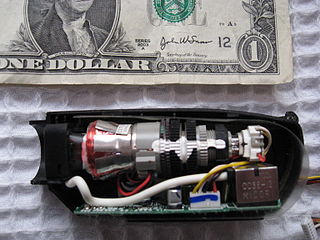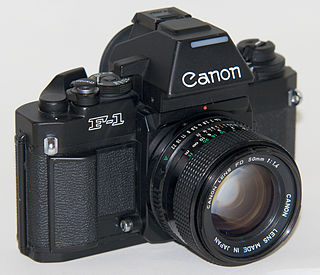
A single-lens reflex camera (SLR) is a camera that typically uses a mirror and prism system that permits the photographer to view through the lens and see exactly what will be captured. With twin lens reflex and rangefinder cameras, the viewed image could be significantly different from the final image. When the shutter button is pressed on most SLRs, the mirror flips out of the light path, allowing light to pass through to the light receptor and the image to be captured.

A camera is an instrument used to capture and store images and videos, either digitally via an electronic image sensor, or chemically via a light-sensitive material such as photographic film. As a pivotal technology in the fields of photography and videography, cameras have played a significant role in the progression of visual arts, media, entertainment, surveillance, and scientific research. The invention of the camera dates back to the 19th century and has since evolved with advancements in technology, leading to a vast array of types and models in the 21st century.

A rangefinder camera is a camera fitted with a rangefinder, typically a split-image rangefinder: a range-finding focusing mechanism allowing the photographer to measure the subject distance and take photographs that are in sharp focus.

A twin-lens reflex camera (TLR) is a type of camera with two objective lenses of the same focal length. One of the lenses is the photographic objective or "taking lens", while the other is used for the viewfinder system, which is usually viewed from above at waist level.

The Nikon F camera, introduced in April 1959, was Nikon's first SLR camera. It was one of the most advanced cameras of its day. Although many of the concepts had already been introduced elsewhere, it was revolutionary in that it was the first to combine them all in one camera. It was produced until October 1973 and was replaced by the Nikon F2. Aspects of its design remain in all of Nikon's subsequent SLR cameras, through the current Nikon F6 film and Nikon D6 digital models. The "F" in Nikon F was selected from the term "re-f-lex", since the pronunciation of the first letter "R" is not available in many Asian languages. That tradition was carried all the way through their top line of Nikon cameras until the introduction of the Nikon D1 (digital) cameras decades later.

The Exakta was a camera produced by the Ihagee Kamerawerk in Dresden, Germany, founded as the Industrie und Handels-Gesellschaft mbH, in 1912. The inspiration and design of both the VP Exakta and the Kine Exakta are the work of the Ihagee engineer Karl Nüchterlein, who did not survive the Second World War.

A pentaprism is a five-sided reflecting prism used to deviate a beam of light by a constant 90°, even if the entry beam is not at 90° to the prism. The beam reflects inside the prism twice, allowing the transmission of an image through a right angle without inverting it as an ordinary right-angle prism or mirror would.

An electronic viewfinder (EVF) is a camera viewfinder where the image captured by the lens is displayed on a small screen which the photographer can look through when composing their shot. It differs from a live preview screen in being smaller and shaded from ambient light, and may also use less power. The sensor records the view through the lens, the view is processed, and finally projected on a miniature display which is viewable through the eyepiece.

In photography, a viewfinder is a device on a camera that a photographer uses to determine exactly where the camera is pointed, and approximately how much of that view will be photographed. A viewfinder can be mechanical, with simple optical components, with precision optics and optical functions, or a digital accessory device used with digital cameras.

A digital single-lens reflex camera is a digital camera that combines the optics and mechanisms of a single-lens reflex camera with a solid-state image sensor and digitally records the images from the sensor.

The Canon F-1 is a 35 mm single-lens reflex camera produced by Canon of Japan from March 1971 until the end of 1981, at which point it had been superseded by the New F-1 launched earlier that year. The Canon FD lens mount was introduced along with the F-1, but the previous Canon FL-mount lenses and older R- series lenses were also compatible with the camera with some limitations. The Canon F-1 was marketed as a competitor to the Nikon F and Nikon F2 single lens reflex cameras by Nikon.

The Canon New F-1 replaced the F-1n as Canon's top-of-the-line 35mm single-lens reflex camera in September 1981. Like the earlier models, the New F-1 takes FD-mount lenses. Although no date has ever been confirmed, it is thought that the last New F-1 was made in 1992. It was officially discontinued in 1994, and factory support ended in 2004.

The Pentax LX is a 35mm single-lens reflex camera produced by Pentax in Japan. It was introduced in 1980 to commemorate the 60th anniversary of Asahi Optical Co., and was produced until 2001. It is the top-of-the-line professional, or "system", camera in the Pentax manual focus range, with manual and aperture priority automatic exposure modes and an advanced light metering system. The LX uses the K mount, which is the Pentax proprietary bayonet lens mount, and has a large body of accessories. The camera has several unique or uncommon features, and compared with contemporary professional camera bodies from rival manufacturers, like the Canon New F-1 or Nikon F3, the LX body is smaller and lighter, weighing in at 570 grams with its standard FA-1 finder.
A reflex finder is a viewfinder system with a mirror placed behind a lens. The light passing through the lens is reflected by the mirror to a focusing screen, usually ground glass. The image formed on this ground glass can be observed directly, giving a waist-level reflex finder, or through a redressing optical device for eye-level viewing, giving an eye-level reflex finder.

Live preview is a feature that allows a digital camera's display screen to be used as a viewfinder. This provides a means of previewing framing and other exposure before taking the photograph. In most such cameras, the preview is generated by means of continuously and directly projecting the image formed by the lens onto the main image sensor. This in turn feeds the electronic screen with the live preview image. The electronic screen can be either a liquid crystal display (LCD) or an electronic viewfinder (EVF).

The Rolleiflex SL66 is a line of medium format single lens reflex cameras made by Rollei, in regular production starting from 1966 until Rollei's bankruptcy in 1982. The SL66 represented a change in direction for Rollei, which until that time had focused almost exclusively on its popular twin lens reflex cameras, the Rolleiflex and Rolleicord.

A pellicle mirror is an ultra-thin, ultra-lightweight semi-transparent mirror employed in the light path of an optical instrument, splitting the light beam into two separate beams, both of reduced light intensity. Splitting the beam allows its use for multiple purposes simultaneously. The thinness of the mirror practically eliminates beam or image doubling due to a non-coincident weak second reflection from the nominally non-reflecting surface, a problem with mirror-type beam splitters. The name pellicle is a diminutive of pellis, a skin or film.

Through the Viewfinder (TtV) photography is a photographic or videographic technique in which a photograph or video or motion picture film is shot with one camera through the viewfinder of a second camera. The viewfinder thus acts as a kind of lens filter. The most popular method involves using a digital camera as the image taking camera and an intact twin-lens reflex camera (TLR) or pseudo-TLR as the "viewfinder" camera. TLRs typically have square waist-level viewfinders, with the viewfinder plane at 90 degrees to the image plane. The image in a TLR viewfinder is laterally reversed, i.e. it is a mirror image. Most photographers use a cardboard tube or other apparatus connecting the two cameras in order to eliminate stray light and prevent reflections from appearing on the viewfinder glass or on the lens of the imaging camera.

The Fuji GX680 is a series of single lens reflex system cameras for medium format film produced by Fujifilm with interchangeable camera lenses and interchangeable film holders for the unusual film format 6×8 cm on 120 and 220 roll film. The distinguishing feature of the Fuji GX680 is the articulating front standard, which runs on a rail connecting lens and camera body by a bellows; the interchangeable lens is permanently mounted to a lens board.

The Rolleiflex SLX is a line of medium format single lens reflex cameras made by Rollei, in regular production starting from 1976. The SLX incorporated electronic autoexposure and motorized film transport, competing directly with the integrated-motor Hasselblad 500EL/M and effectively displacing the earlier Rolleiflex SL66 line, although the older camera continued to be produced.




















